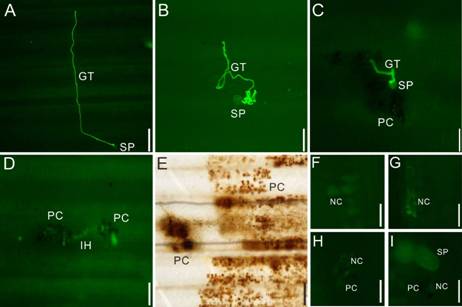Wheat stripe rust, caused by Puccinia striiformis f. sp. tritici (PST), is one of the most destructive diseases and can cause severe yield losses. Dissecting molecular mechanisms of interaction between wheat and PST is the key to breed wheat cultivars with durable resistance to PST. However, the large size and complexity of wheat genome is a bottleneck to study the resistance mechanisms. Brachypodium distachyon is a new model species for functional genomics analysis of temperate grain cereals, including wheat and barley. Qi Xiaoquan group explored the potential of Brachypodium distachyon-wheat stripe rust as a model pathosytem for studying the mechanism of nonhost resistance. In this study more than 200 mutants that are more resistant or susceptible to PST than the wild type Bd21 were identified from a large T-DNA insertion population. Microscopic observation revealed different infection processes of wheat stripe rust in susceptible mutants and Bd21. The T-DNA flanking sequences and mutation sites of several susceptible mutants were identified. Further genetic analysis predicted the putative genes pertaining to disease resistance. These results demonstrated that the Brachypodium distachyon-wheat stripe rust is a good model pathosystem for studying the nonhost resistance.
This work has been published in Scientific Reports (http://www.nature.com/articles/srep25510), PhD student AN Tianyue is the first author of the paper. The research has been supported by grants from the National Natural Science Foundation of China.

Figure: The microscopic observation of nonhost resistant response of Brachypodium distachyon to wheat stripe rust. (A-E) showed the infection processes of wheat stripe rust in Brachypodium distachyon were inhibited. (F-I) showed the hypersensitive response appeared in the leaves of Brachypodium distachyon. SP, spore of wheat stripe rust; GT, germ tube; PC, pigmented cells; IH, infection hypha; NC, necrotic cells.
CONTACT INFO:
Prof. QI Xiaoquan
Key Laboratory of Plant Molecular Physiology
Institute of Botany,
Chinese Academy of Sciences,
20 Nanxincun, Xiangshan, Beijing 100093, China
E-mail: xqi@ibcas.ac.cn
Wheat stripe rust, caused by Puccinia striiformis f. sp. tritici (PST), is one of the most destructive diseases and can cause severe yield losses. Dissecting molecular mechanisms of interaction between wheat and PST is the key to breed wheat cultivars with durable resistance to PST. However, the large size and complexity of wheat genome is a bottleneck to study the resistance mechanisms. Brachypodium distachyon is a new model species for functional genomics analysis of temperate grain cereals, including wheat and barley. Qi Xiaoquan group explored the potential of Brachypodium distachyon-wheat stripe rust as a model pathosytem for studying the mechanism of nonhost resistance. In this study more than 200 mutants that are more resistant or susceptible to PST than the wild type Bd21 were identified from a large T-DNA insertion population. Microscopic observation revealed different infection processes of wheat stripe rust in susceptible mutants and Bd21. The T-DNA flanking sequences and mutation sites of several susceptible mutants were identified. Further genetic analysis predicted the putative genes pertaining to disease resistance. These results demonstrated that the Brachypodium distachyon-wheat stripe rust is a good model pathosystem for studying the nonhost resistance.
This work has been published in Scientific Reports (http://www.nature.com/articles/srep25510), PhD student AN Tianyue is the first author of the paper. The research has been supported by grants from the National Natural Science Foundation of China.

Figure: The microscopic observation of nonhost resistant response of Brachypodium distachyon to wheat stripe rust. (A-E) showed the infection processes of wheat stripe rust in Brachypodium distachyon were inhibited. (F-I) showed the hypersensitive response appeared in the leaves of Brachypodium distachyon. SP, spore of wheat stripe rust; GT, germ tube; PC, pigmented cells; IH, infection hypha; NC, necrotic cells.
CONTACT INFO:
Prof. QI Xiaoquan
Key Laboratory of Plant Molecular Physiology
Institute of Botany,
Chinese Academy of Sciences,
20 Nanxincun, Xiangshan, Beijing 100093, China
E-mail: xqi@ibcas.ac.cn